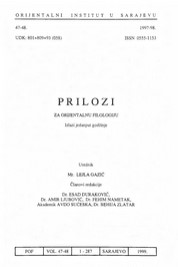GLOBUSI ZEMLJE SALIHA HADŽIHUSEJNOVIČA MUVEKITA
TERRESTRIAL GLOBES OF SALIH HADŽIHUSEJNOVIĆ MUWEKIT
Author(s): Jasminko Mulaomerović, Edina Sikirić-VehabovićSubject(s): Maps / Cartography, Preservation, 19th Century
Published by: Orijentalni Institut u Sarajevu
Keywords: Terrestrial globes; Salih Hadžihusejnović; Muwekit; Old astronomical instruments; Part of the Collection of Husrev Bey library in Sarajevo; Mathematical and geographical elements of the larger scale;
Summary/Abstract: At muwekitnamahs, the institutions which took care of exact time, preserved was a larger number of old astronomical instruments and equipment, such as quadrants, octants, sextants, timepieces, etc. In the paper, special attention has been drawn to two terrestrial globes. Nowadays they are kept in the Collection of Husrev Bey library (being established) in Sarajevo. All the toponyms were written in black indelible ink, in larger letters the names of continents, oceans, states, the North and South Poles, and in smaller letters other toponyms. State borders were not marked, and hydrographical network was very inadequately drawn in. Antarctica, which was still being searched for at the time the globe was made, was not drawn in either. On the smaller scale globe the contours of Australia were inaccurately drawn in, especially of the southern parts of the continent. Tasmania was presented as a peninsula. Serious errors were committed by the author at drawing in the northern contours, especially for the area of Amhem Land and the peninsula of York. The contours of Africa were quite well drawn in, which also goes for Europe’s and Asia’s contours (except the northern parts of the continent). Also quite well drawn in were the contours of South America, but errors were committed for the northern, north-eastern and north-western parts of the continent. On the larger scale globe, much better drawn in were the southern contours of Australia, and Tasmania was presented as an island. The contours of Americas were quite precisely drawn in. On both globes there is the ecliptic with the Zodiac. Mathematical and Geographical Elements of the Smaller Scale Globe - On the basis of Pole to Pole meridian length, which is d=522m, and the one in Nature D=20,000km, we get the module scale N=D/d, i.e. the scale R=l/N. The result is R=1:38,000,000 (the nearest rounded off scale). This scale is at the same time standard and is often found in school globes. From the scale it appears that the globe radius is r=167.63mm.
Journal: Prilozi za orijentalnu filologiju
- Issue Year: 1996
- Issue No: 44-45
- Page Range: 391-403
- Page Count: 13
- Language: Bosnian

